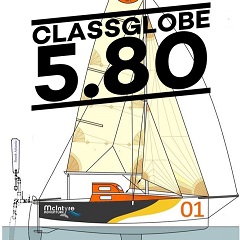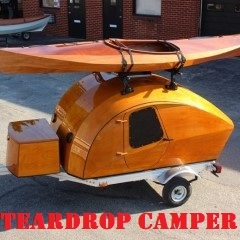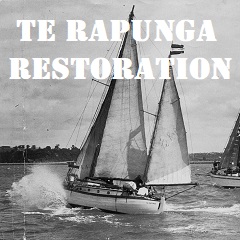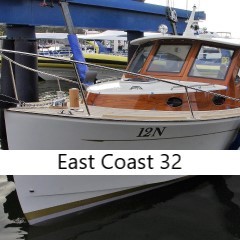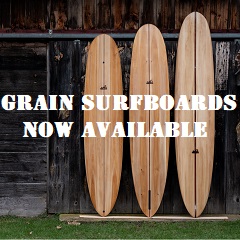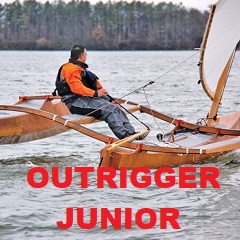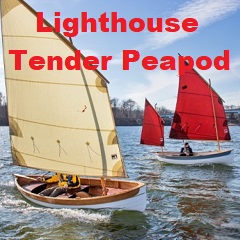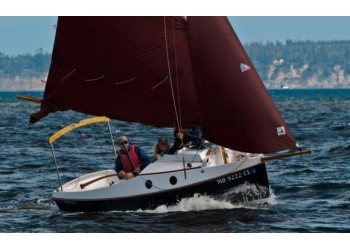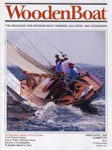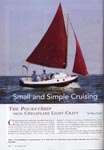|
Designer John C. Harris has designed, built, owned, and cruised aboard a variety of smallcraft. His first camp-cruiser as a teenager was an 11'6" rowing boat with a tent, in which he explored the upper Chesapeake, sleeping aboard. Twenty years later, he wanted a fast-sailing pocket cruiser with a dry and commodious interior. It had to be quick and easy to build or the project would never get finished, so stitch-and-glue plywood construction was a given from the start. The cockpit was laid out for daysailing comfort and is large enough for sleeping on warm nights.

Interior arrangements are ample, we think bigger and more comfortable than anything else this size, without compromising Pocketship's looks and performance. Two adults may sleep below or wait out a rain shower, and a portable head stows beneath the cockpit, sliding forward into the cuddy for use. The enclosed area of the cabin is identical to an average four-man tent, but drier, more private, and more secure.
Geoff Kerr of Two Daughters Boatworks built the first hull. He started in mid-January 2008 and clocked about 525 hours before delivering a finished hull and spars, ready for hardware. PocketShip was rigged at CLC and launched on May 10th, 2008. The typical amateur builder might require about 30 weekends and occasional evenings to see this one through.
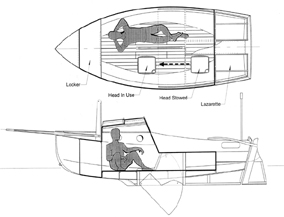 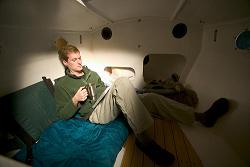
PocketShip's big interior.
Plans comprise 11 pages of architectural drawings, and full-sized patterns for nearly every part in the boat. Plans and manual are in both metric and standard measurements. The manual is 280 pages, spiral-bound, and lavished with nearly 800 images and drawings showing construction step-by-step. Kits include the pre-cut plywood parts, epoxy, and fiberglass for the hull. Since solid timber (floorboards, stringers, rails, spars) is available everywhere inexpensively, it will be sourced and milled by the builders. Due to the shipping challenges, lead ballast is not included in the kit. Sails and hardware are available in several packages.
2008 sailing trials in varied waters from Maine to Maryland included crews of 1 to 4 adults and wind conditions of 0-20 knots. PocketShip is stiff and fast and tacks through 90 degrees. The helm is light and the boat will spin nearly in its own length in both light and heavy air and with a variety of sail combinations. We are thrilled with performance and handling---all expectations have been exceeded.
You can see the “Construction Gallery” on CLC's website to see a step-by-step commentary by John Harris about the design and construction of PocketShip. You'll need to enlarge the pop-up Gallery window or scroll down to read the captions that accompany each image. Click their "Main Gallery" link to see more photos of PocketShip under sail in a variety of wind and sea conditions.
Peter, a local resident in Port Huon Tasmania, has completed the substantial endeavor of constructing a PocketShip, Kermadec in 2018. He has documented and published the entire process from start to finish which can be found here.
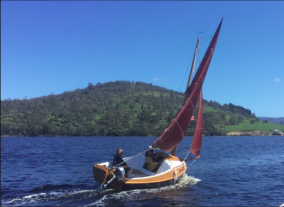
Peter's PocketShip Kermadec on the Huon River
Many ask about auxiliary power for PocketShip. While the boat's sailing qualities are sufficient to undertake long expeditions in challenging waters without power, many sailing examples have small outboards mounted on a stern bracket for negotiating marinas, channels, or flat calms. We've seen up to five horsepower, but two horsepower is ample even for rough conditions. The excellent Honda four-stroke 2hp is light enough not to diminish sailing qualities. Aftermarket outboard brackets are plug-and-play without modification to the transom. John Harris built this simple outboard bracket for PocketShip #1 and it has worked admirably.
"Go simple, and if that appeals to you then there is no more simple way to cruise than this design from John C. Harris. ...This is one dandy looking little boat. It’s shapely, with lots of sheer, a pugnacious bow profile and sweet overall hull lines." Robert H. Perry, Sailing Magazine June 2009
FAQ:
What is included in the PocketShip Base Kit?
The PocketShip base kit contains the following;
-
Hull panels, bulkheads, decks, keel, rudder, centreboard, and all plywood components. All parts are CNC-cut from 17 sheets of BS1088 marine plywood. Hull panels feature "puzzle joints" for rapid and accurate assembly.
-
Hull panels and bulkheads are pre-drilled on the CNC machine for assembly with wire stitches.
-
MDF Patterns for nearly all the solid timber parts are CNC-cut, ready to trace onto timber.
-
CNC-cut parts for the building cradle
-
57L of West System resin and hardener
-
48L of epoxy thickeners
-
60m of 6-ounce fiberglass fabric
-
46m of fiberglass tape
-
11 pages of architectural drawings and 280-page manual.
Solid timber parts (spars, rails, stringers, cleats, floorboards, etc.), lead ballast, hardware, fasteners, rigging, and sails are not included in this kit and will need to be procured separately.
What is included in the PocketShip CNC Cut Ply Components Kit?
The PocketShip CNC Cut Ply Components kit contains the following;
-
Hull panels, bulkheads, decks, keel, rudder, centreboard, and all plywood components. All parts are CNC-cut from 17 sheets of BS1088 marine plywood. Hull panels feature "puzzle joints" for rapid and accurate assembly.
-
Hull panels and bulkheads are pre-drilled on the CNC machine for assembly with wire stitches.
-
MDF Patterns for nearly all the solid timber parts are CNC-cut, ready to trace onto timber.
-
CNC-cut parts for the building cradle
-
11 pages of architectural drawings and 280-page manual.
Solid timber parts (spars, rails, stringers, cleats, floorboards, etc.), lead ballast, hardware, fasteners, rigging, fiberglass, epoxy, and sails are not included in this kit and will need to be procured separately.
What is included in the PocketShip Plans and Manual Package?
Plans comprise full-sized patterns for almost every part in the PocketShip. Spread the patterns out on your plywood sheets, transfer the shapes, and cut them out with a sabersaw. The plans package includes patterns and instructions for options such as the sails and spars etc.
What is the difference between the CLC and Denman Marine packages?
The CLC packages are shipped directly from the US with only minimal substitutions made (e.g. sail track) and the CLC sailing hardware components consist mostly of Harken.
The Denman Marine packages use hardware that is sourced through our regular suppliers, while this will be a mix of manufacturers, we have worked hard to compile a list of the best hardware available locally, including Barton hardware where applicable. It is worth noting that the Denman Marine packages will not match exactly what is described in the manual.
How long will it take to build?
If you can spare approximately 30 weekends (~500 hours) and know your way around some basic tools, you can build yourself an excellent little PocketShip and be on the water before you know it. Coating, sanding, and finishing are straightforward but time-consuming. The fit-out (hardware, electrical system, etc.) will vary a lot from project to project. Some builders will keep it really simple, others will outfit theirs with extravagant electrical systems and fittings. That's part of the fun of doing it yourself!
How will the PocketShip kit be shipped?
Due to the PocketShips bulk in kit form, and in order to protect the pieces in transit, all components have been left tabbed into larger sheets of plywood, simply punch out the pieces with a chisel or jigsaw and dispose of the unnecessary plywood. You will receive a strapped and protected pack of plywood that weighs around 280kg, please ensure you have somewhere clear for its delivery before unpacking it (2500x1220x200mm). In most cases this will be delivered on a tail gate truck allowing for easy drop off, otherwise it may need to be pulled apart and unloaded by hand.
Can you supply additional components?
We can supply the same additional components as CLC in the US, e.g. Timber Package, Sailing Hardware, Sails, Hull Hardware, Running Rigging etc. Please contact us for further information and pricing.
Can Denman Marine build me a PocketShip?
Denman Marine can build any kit from CLC's range to your specifications, and completed the first Denman Marine built PocketShip for a customer in NSW in late 2018.
Completed vessel ready to sail, including;
-
Sails - main, jib in white, cream or tanbark red.
-
Spinnaker - single colour and running gear
-
Planking and general hull construction in BS1088 Gaboon/Okoume Marine Plywood
-
High - quality marine plywood and WEST System epoxy resin/fibreglass construction
-
Hard wearing two pack paint below/above waterline and interior (choice of colours – dark hull colours will add $750)
-
All deck hardware, as well as running and standing rigging
-
Timber spars (gaff rig as designed)
-
Galvanised road trailer including tie down, jockey wheel and spare tyre
Price for the above starts at around $49,900 (subject to change). She is around 500 hours to build and a complex little boat at that.
There is also the possibility of customizing and adding other items such as a small electrical system, outboard motor etc. We would price these for you on request.
Please contact us if you are interested in a PocketShip built by Denman Marine.
Can I download the plans?
Not yet. We might develop a downloadable version of the plans in the future, but for now we'll be mailing tubes with full-sized patterns.
I have access to a CNC machine, can you send me the CAD files?
Not until digital-rights management for architectural work catches up to books and music. Yes, we wish it was that easy, too! But in a world swarming with intellectual property thieves, the technology simply isn't ready.
Builders are sharing photos and experiences at the official PocketShip bulletin board, PocketShip.net
|
As seen in WoodenBoat #207
|
|
|
|

